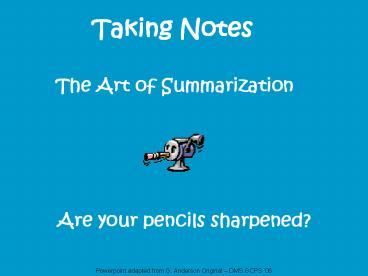Taking Notes - PowerPoint PPT Presentation
Title:
Taking Notes
Description:
Title: PowerPoint Presentation Author: Gloria Anderson Last modified by: Christina Arpante Created Date: 11/14/2005 12:37:08 AM Document presentation format – PowerPoint PPT presentation
Number of Views:140
Avg rating:3.0/5.0
Title: Taking Notes
1
Taking Notes
- The Art of Summarization
Are your pencils sharpened?
Powerpoint adapted from G. Anderson Original
DMS GCPS 06
2
What is summarizing?
- Restating the main idea(s) into your own words
- include only the main point(s) (significant
evidence/details) - considerably shorter than the original and take a
- expansive synopsis of the original source
3
Why Summarize?
- Takes less room
- Faster
- Helps you understand the information
- Helps avoid plagiarism
4
What is Plagiarism?
- Taking someone elses words, or even their ideas
and research and using them as if they are your
own. - stealing words/ideas
5
Plagiarism is Not Acceptable
- It is a type a stealing.
- Your ideas and words are intellectual property
6
Summarizing Steps
- Skim the material to be summarized.
Make sure you always refer back to the
original source within the text or by MLA
citation.
7
- Identify key words and phrases you think are
important or that are needed. Then,
paraphraseput into your own words.
- What is paraphrasing?
- rewriting a passage into your own words
- usually shorter than the original
8
- Helpful summarizing strategies
- Abbreviations
- Bullets
- Lists
- Create an identification system for topics/items
the teacher puts emphasis - A star () for likely test items or topics.
- Underline repeated items.
- Circle what you don't know or are unclear (?)
about, then leave blank space to fill in the
correct information later. - Box for key concepts that you need to remember.
9
- 3. Put quotation marks around phrases or
sentences that will make a strong impression on
your readers. - However, use quotations sparingly.
10
- 4. Cite the source of your quotation in
parentheses. (authors last name and page )
A basic axiom of learning is that the easiest
way to learn something new is to associate it
with something we already know (Hirsch 21).
11
Practice your note taking
- use television or radio programs, summarize
and/or short-periods of time, increasing over
time. - compare with classmates to see if everyone wrote
the same main points.
12
Works Cited
- Hirsch, D. The Theory Behind the Dictionary.
Dictionary of Cultural Literacy. Boston Houghton
Mifflin, 2002. - Information Skill of the Month Strategies in
the Bag. School Library Media Activities
Monthly. September 2005, 221. Accessed 15
October 2005. lthttp//www.slmam.comgt.































